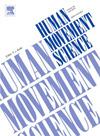“Acute responses to barefoot running are related to changes in kinematics, mechanical load, and inflammatory profile”
IF 1.9
3区 心理学
Q4 NEUROSCIENCES
引用次数: 0
Abstract
This study investigated the acute effects of barefoot (BF) running on biomechanical parameters and cytokine concentrations. Seventy-one habitually shod runners had biomechanical parameters evaluated during running shod (SH) and BF, while a sub-group of 19 runners had their inflammatory profile analyzed before and after a running session, using their habitual shoes or barefoot. Running BF changed spatiotemporal and joint kinematics, including the stride frequency (increased) and length (decreased), and foot strike pattern (more plantarflexed ankle at initial contact). An increased impact force was observed (p < 0.05), while joint moment, power, and work were also affected by BF running: a shift of joint load from the knee and hip to the ankle occurred (p < 0.05). In cytokine levels, maintenance (all cytokines, except Eotaxin, IL-12p40, IL-2, IL5, and MIP-1 beta) or reductions (IL-12p40, IL-2, and IL5) were observed as an acute response to BF running, what means to keep or reduce the levels of pro-inflammatory cytokines and immunological/chemoattraction proteins when compared to SH. Summarily, a single session of BF running may not represent enough stress to induce changes in the inflammatory profile. Besides the increased impact force, the joint load was reduced during short-term BF running. Nevertheless, short-term BF running should be cautiously applied due to the shift of joint load from the knee and hip to the ankle.
"赤足跑步的急性反应与运动学、机械负荷和炎症特征的变化有关"。
本研究调查了赤足(BF)跑步对生物力学参数和细胞因子浓度的急性影响。71名习惯穿鞋的跑步者在穿鞋(SH)和赤足跑步过程中接受了生物力学参数评估,19名跑步者在使用习惯鞋或赤足跑步前后接受了炎症概况分析。赤足跑步改变了时空运动学和关节运动学,包括步频(增加)和步长(减少),以及足部着地模式(初次接触时踝关节更多的跖屈)。观察到冲击力增加(p
本文章由计算机程序翻译,如有差异,请以英文原文为准。
求助全文
约1分钟内获得全文
求助全文
来源期刊

Human Movement Science
医学-神经科学
CiteScore
3.80
自引率
4.80%
发文量
89
审稿时长
42 days
期刊介绍:
Human Movement Science provides a medium for publishing disciplinary and multidisciplinary studies on human movement. It brings together psychological, biomechanical and neurophysiological research on the control, organization and learning of human movement, including the perceptual support of movement. The overarching goal of the journal is to publish articles that help advance theoretical understanding of the control and organization of human movement, as well as changes therein as a function of development, learning and rehabilitation. The nature of the research reported may vary from fundamental theoretical or empirical studies to more applied studies in the fields of, for example, sport, dance and rehabilitation with the proviso that all studies have a distinct theoretical bearing. Also, reviews and meta-studies advancing the understanding of human movement are welcome.
These aims and scope imply that purely descriptive studies are not acceptable, while methodological articles are only acceptable if the methodology in question opens up new vistas in understanding the control and organization of human movement. The same holds for articles on exercise physiology, which in general are not supported, unless they speak to the control and organization of human movement. In general, it is required that the theoretical message of articles published in Human Movement Science is, to a certain extent, innovative and not dismissible as just "more of the same."
 求助内容:
求助内容: 应助结果提醒方式:
应助结果提醒方式:


